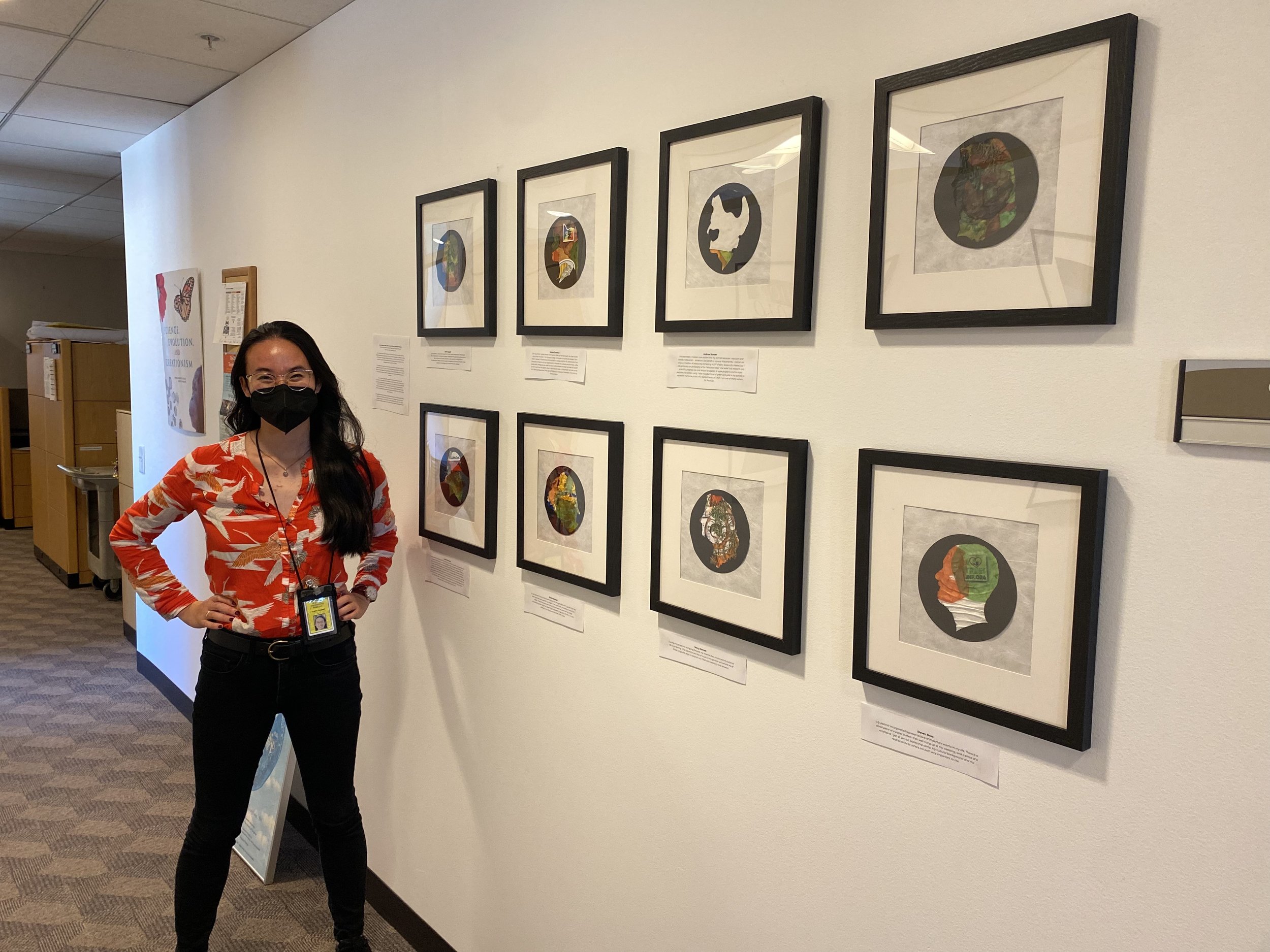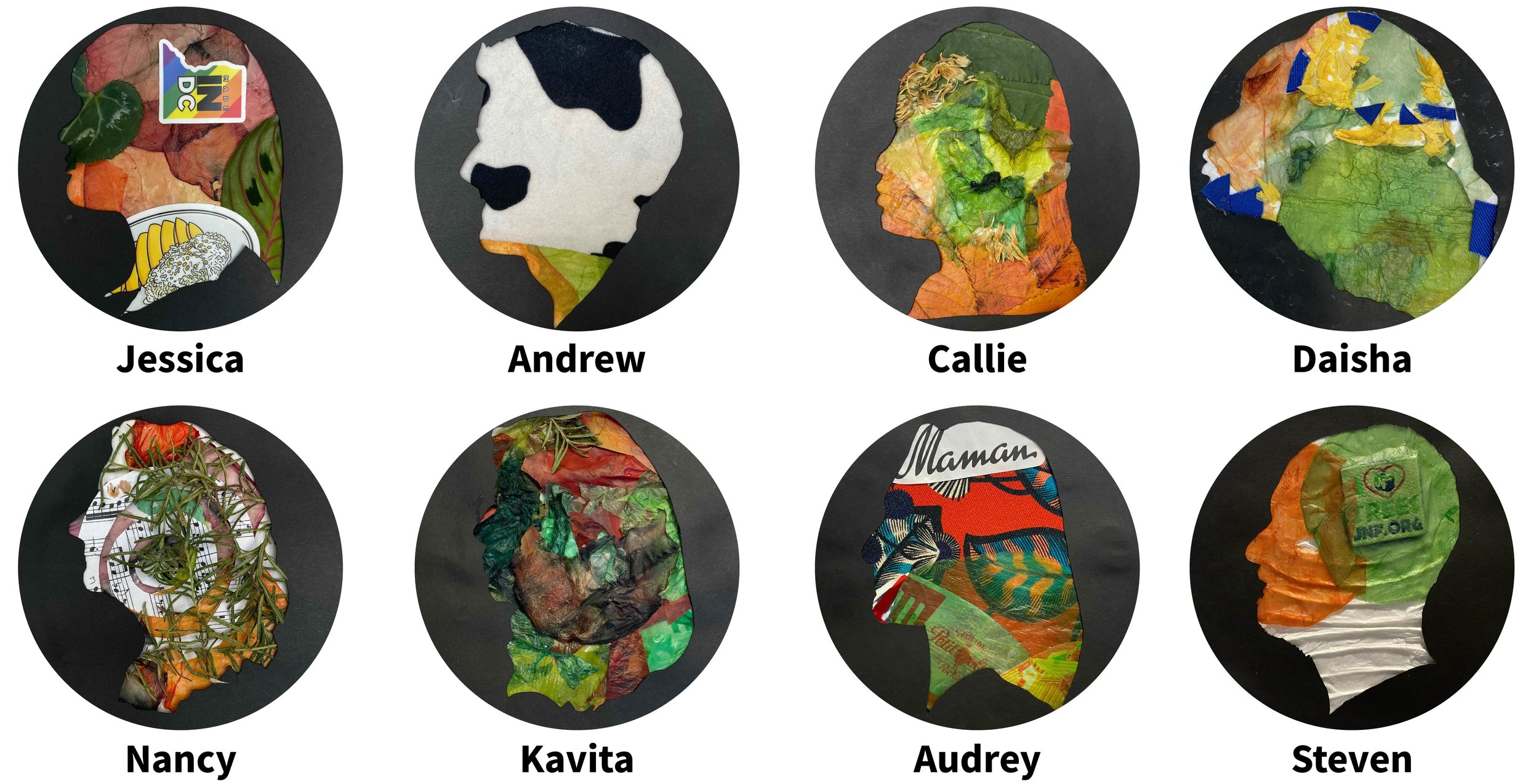Art
social culture and microbial culture, bacterial cellulose and mixed media (2021)
I’ve always been a portrait artist, which is to say, I’ve always been a naturalist.
At first, it started with faces. Somehow, studying each face, familiarizing myself with each eyelash, the subtle way hair falls, the curvature of a jawline, was a way for me to relate deeply to a subject. I felt close to them. I felt faces frozen in time, even after they were long gone.
Increasingly, I’ve focused on environmental art. In studying a tiger’s fur, the curve of a mushroom, or a field running into the sea, I bring that same sense of wonder and curiosity. To me, the artistic eye of a portrait artist is the same of that as a field biologist, a naturalist. Taking delight in the distribution of plants, the passing marks of traveling animals, listening to bird calls is another way to appreciating the world through the eyes of an artist.
Ecology is the science of looking, listening, and hearing the world, then representing what it tells us. In the same way, portraiture is one lens to do the same: to understand, to explore, to celebrate the world.
My fine art practice spans ecological art, biodesign, community-engaged workshops, and traditional art media. Read on!
Stay connected on Instagram (@eco_genome)
Ecological Art
As an ecologist, I am passionate about exploring relationship with land. I use art to foster conversations about anthropocentrism, ecology, and colonialism.
Land-based learning: Cyanotypes
During the summer of 2023, I was a joint artist in residence at the University of Michigan Biological Station and Michigan State University’s W.K. Kellogg Biological Station. During this residency, I led a series of science/art workshops with research faculty, undergraduate students, and non-academic community members. Participants shared stories about their relationship with land, foraged for wild plants, and created cyanotype sunprints that represented their stories. Since the workshops where held outdoors, participants were able to swim and wash their sunprints in the lake.
Nectar Microbes exhibition
At my PhD defense, I had a full art exhibition highlighting aspects of my dissertation research. This included a DNA music box playing a DNA sequence from the species of nectar inhabiting yeast that I study, M. reukaufii, large transparent window decals of agar plates with nectar microbes growing on them, a pollinator biocircuit with live flowers of the species that I study, D. aurantiacus, original photography, and a large quilt collaboratively sewn by my research community.
Biomaterials, biodesign, and synthetic biology
If we’re reimagining biology through art, why not make art with biology? I create art using biomaterials such as kombucha SCOBY, growing mycelium, and more.
IndiGROW
In 2024, I exhibited several pieces (IndiGROW) with Dr. Nasa Sinnott-Armstrong as part of Fathomers Emergence: Art from Life, an exhibition at the Japanese American Culture and Community Center in Los Angeles, CA. Fathomers is a creative research institute, which hosted a group show about synthetic biology as part of the Getty Foundation’s PST: Art and Science Collide throughout Southern California.
We exhibited indigo-like dye produced by bioengineered yeast. This exhibit, which included an interactive component, highlighted the colonial history of indigo and warned of a future with bioengineering that could reify similar violence.
Exhibited artwrorks:
Flask, 2024. Bioengineered yeast, DMSO, indigoidine dye, platform, liquid culture media, glass flask; 12 x 19 in. Jeans, 2024. Bioengineered yeast, indigoidine dye, denim, clothing rack; 45 x 54 in. Dying Indigo, 2024. Bioengineered yeast, indigoidine dye, microcentrifuge tubes, tabletop greenhouse, glass flask, printed cards; 30 x 60 in. Lil Lab, 2024. Glass cabinet, cyanotype papers, foldscopes, zines, stickers; 16 x 14 x 61 in. Cushions, 2024. Fabric, indigoidine dye, Inidgofera plant leaves, chemically synthesized reduced indigo; 24 x 24 in.
Kombucha Portraits
In 2021, I created a collaborative biomaterials exhibition at the National Academy of Sciences. With my scientist colleagues, I grew kombucha SCOBY in petri dishes. I used the dried SCOBY to decorate silhouettes of each colleague, which we blended with culturally-relevant items to create microbial portraits.
Installation at the National Academy of Science, Engineering, and Medicine Keck Building in Washington, DC.
Dyed kombucha SCOBY grown in petri dishes.
Individual portraits created by BLS staff (2021)
Mycelium sculptures
In 2022, I created a large workshop where participants created playful mycelium sculptures of culturally significant “pocket foods.” Flash frozen pierogi, empanadas, samosas, crescent rolls, and even Capri Sun were vacuum formed into molds. These molds were pressed with sterilized kitchen waste such as coffee grounds, rice, and tea leaves, and inoculated with reishi mycelium from Mycoworks.
In 2021, I was scientific consultant on a mycelium quilt project led by Corinne Okada Takara: BioQuilts. In that project, we held community-engaged workshops where participants grew quilt squares out of mycelium. This work was funded by the San Jose Museum of Quilts and Textiles.
Community art workshops
Where does art happen? I believe the best art is made on the street, in the lab —unexpected places. During one workshop, entitled Reimagining biological mythologies, I invited scientific researchers at Stanford to reimagine science superpowers. Participants took inspiration from the mythological and biological concept of a chimera. Chimeras are hybrids that take parts from biological creatures and our own cultural imagination to embody imaginative traits.
What are the traits that we imagine to represent our science superpowers? What are the cultural, biological, and political references we can create chimeras of to represent these traits?
Participants created small statues/idols of our chimeras using an unexpected material, recycled lab plastics, to re-envision what science is and can be. By repurposing materials (plastics) that represent the status quo of science and colonial pollution, I wanted to reimagine them–through recycling– and us, as scientists, into the liberatory and transformative futures of our dreams.
Final artwork was exhibited at Santa Clara University, as part of Floating Kīpuka /Dreaming the Futures We Want to Grow, with Corinne Okada Takara.
Traditional media
I also enjoy plein air painting, graphite/charcoal drawing, woodblock printing, and photography.
Plein air acrylic in Santa Cruz, California (2021)
Sunset over Russian Ridge Open Space Preserve, California (2022)
Barn owl, pen and ink on watercolor (2016)
Eye of the tiger, woodblock print (2022)
Bioluminescence, watercolor on black paper (2022). Text based on this poem by Paul Tran.








































